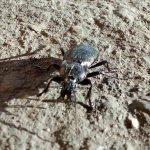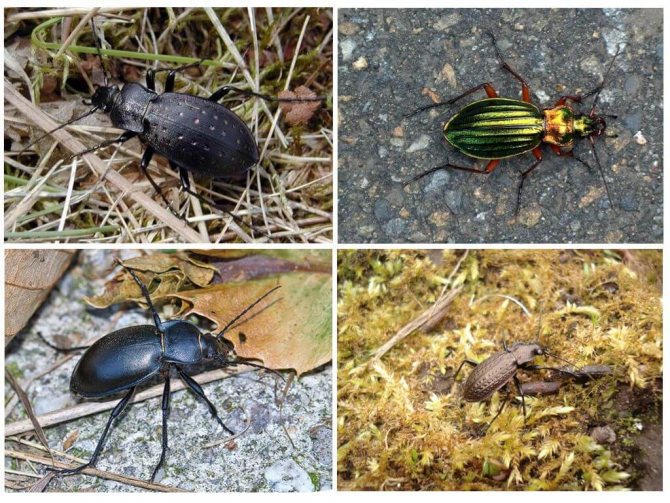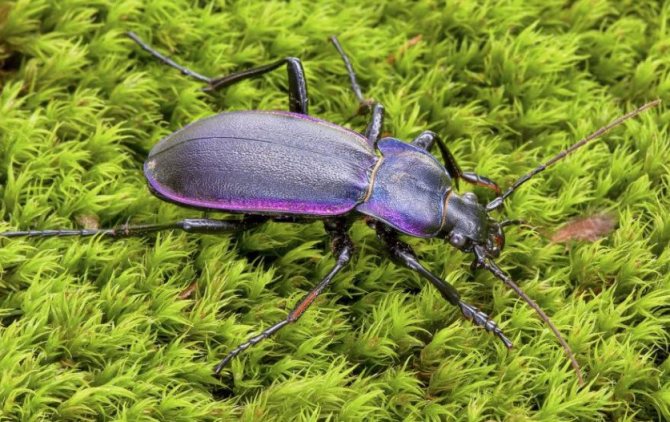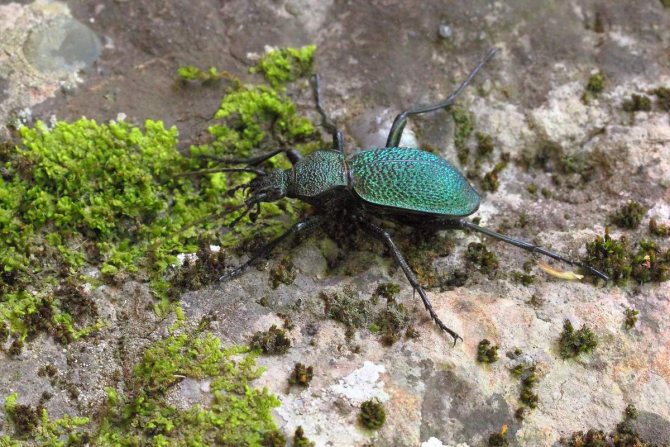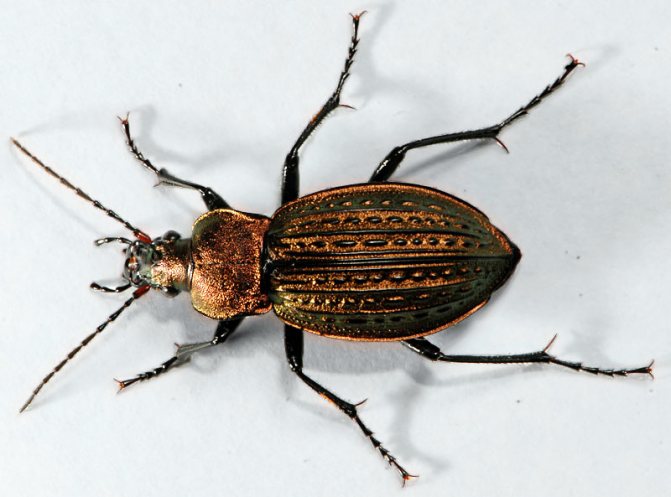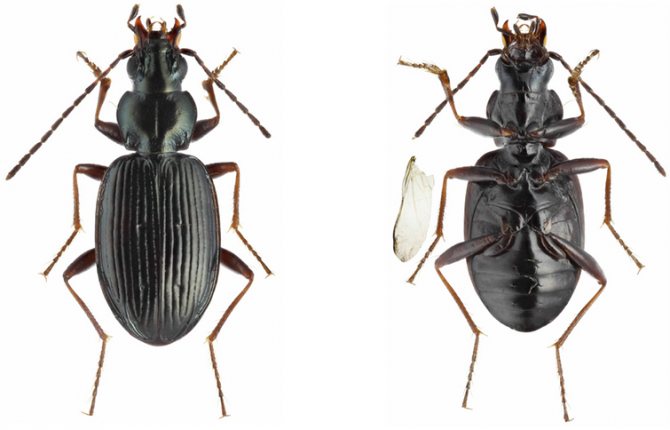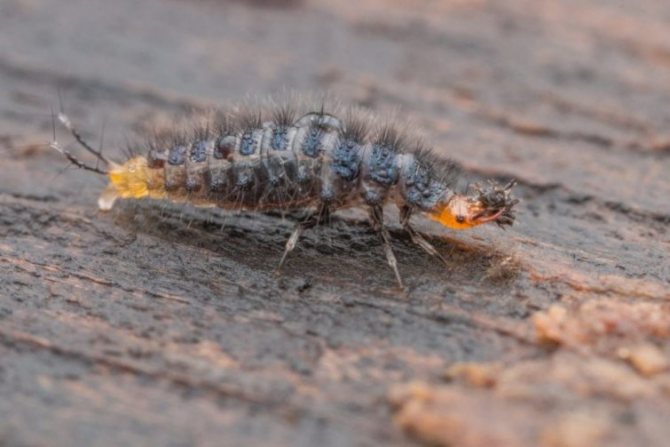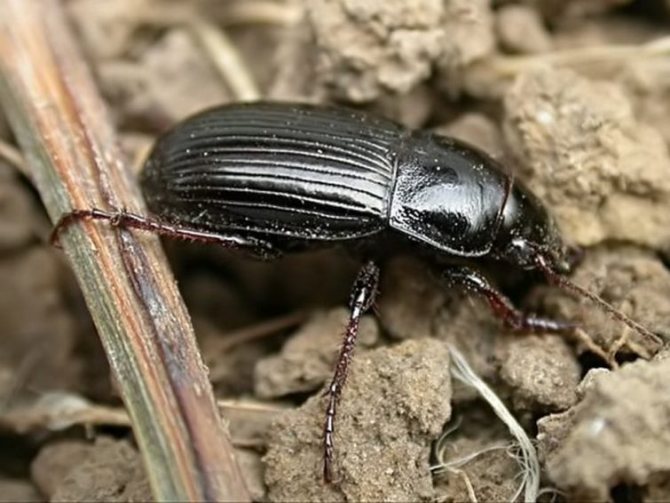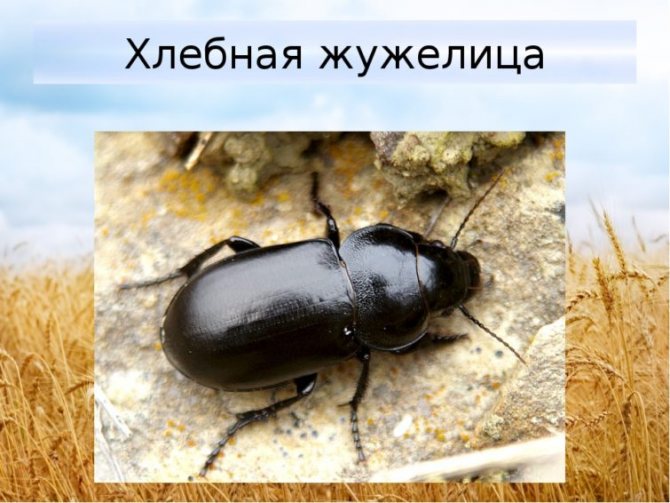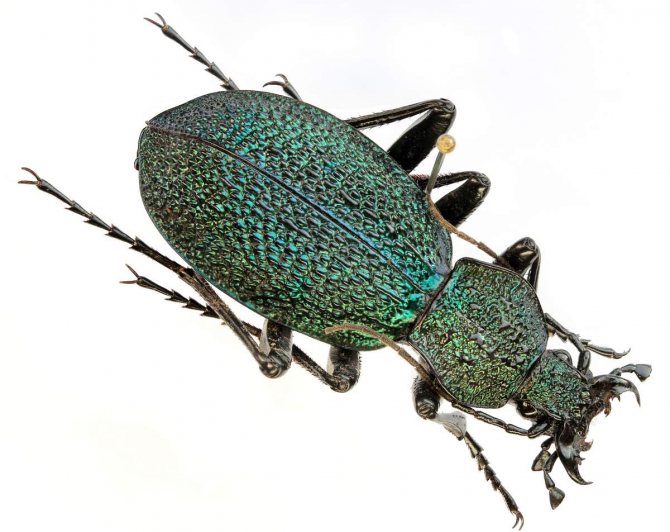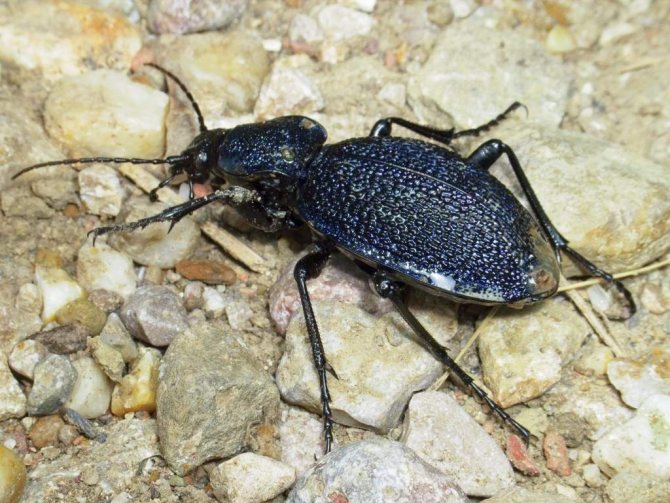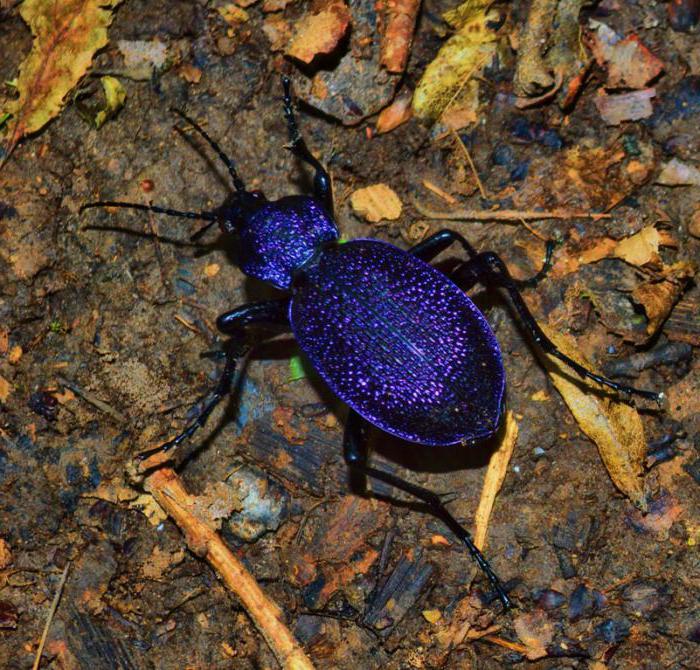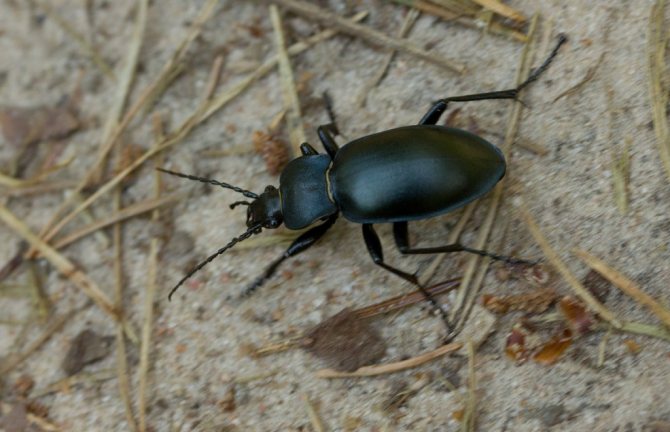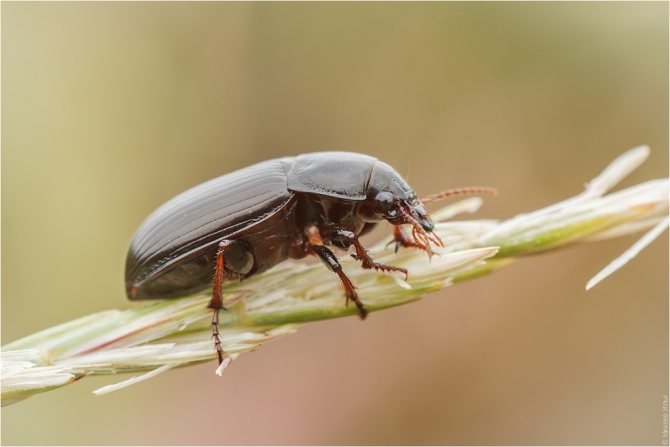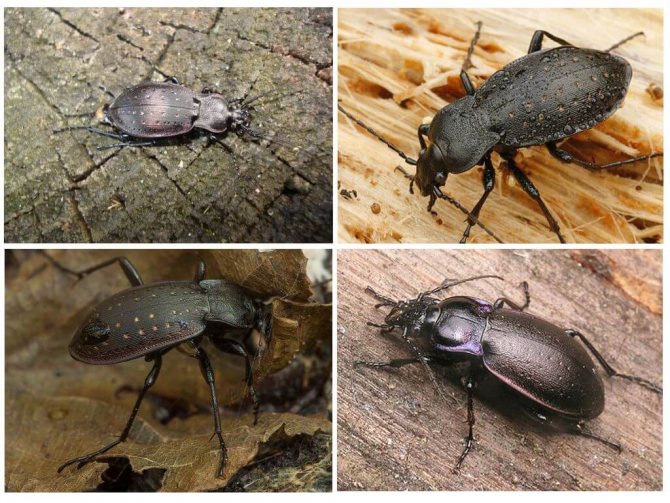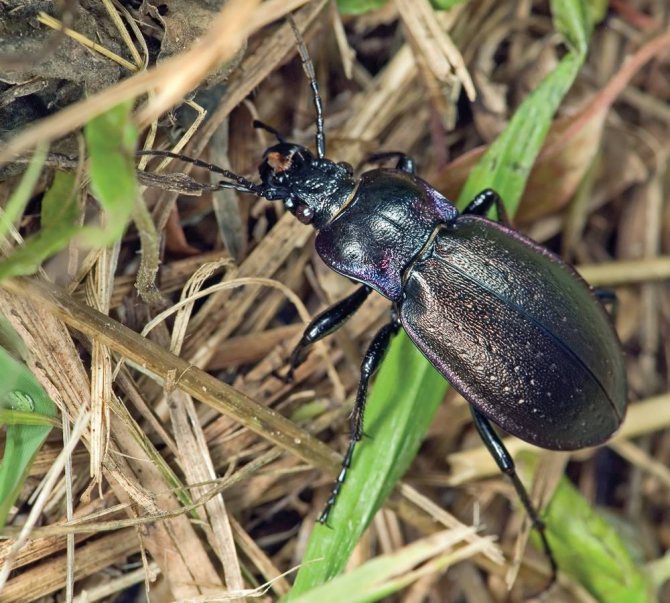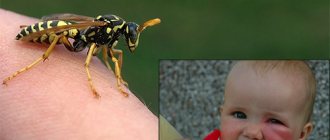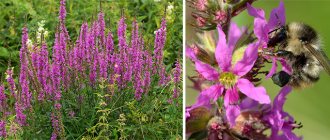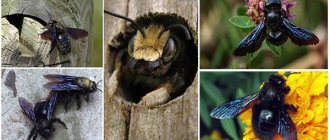A widespread and numerous species of insects is the ground beetle. It inhabits all geographic zones due to its ecological plasticity. There are more than 50,000 species in the world - representatives of this family, of which about 3,000 species are found in Russia. There is debate about the practical value of ground beetles among people: some believe that this beetle is a pest of garden crops and cereals, others attribute the species to useful insects that destroy caterpillars, snails and slugs. To find the answer to the question, you will need to consider what types of ground beetles are found on the territory of our country.
Ground beetle photo
The family includes many species and genera that differ little from each other. To diagnose beetles, it is required to take into account many nuances - from the color and shape of the insect to the structure of the genitals.

The ground beetle that lives in Russia, in the photo, most often has an elongated body up to 8 cm long. The wings of an insect are not intended for flight. Beetles move through the air only for settling, but the main means of transportation are fast, long legs. Some members of the family have no wings.
Habitat
The main habitat for this subspecies of ground beetles is dry forests and oak forests. Some individuals reach mountain and meadow steppes up to 2000 meters above sea level. Quite often, the Caucasian ground beetle is found in parks and gardens, and can also inhabit other cultural areas near the main habitat.


Ground beetle description
Ground beetle is a representative of beetles with a large number of species and genera, the description can be presented in the form of characteristic features:
- dark color with a metallic tint;
- segmented body shape;
- transverse lines on a black background for a rainbow effect;
- body shape from rounded to elongated, stem-shaped;
- body sizes from 1 mm to 10 cm;
- long and thin limbs for fast movement;
- wings with caraboid venation;
- hard elytra completely cover the abdomen.
To identify a specific type of ground beetle, it is necessary to take into account the smallest nuances of the structure of the limbs and jaw apparatus, color and body size.
The appearance of insects in the garden
Most gardeners and gardeners, when they see ground beetles in their garden, do not even suspect that they are useful. Very often, when they see beetles, they immediately destroy them. Among many species, there is only one most harmful representative - the bread beetle. She is really capable of causing great harm to agricultural plants. It is also called the humpbacked peun. It is very similar to the garden one, but the pest has shorter legs and a dark, almost black color.
These insects are capable of destroying cereal crops. They eat the ears when they are full of grain. After that, the plants look threshed. The larvae destroy the roots and seeds that germinate in the soil. When there are too many pests, they are able to destroy large areas of crops. At the summer cottage, they appear if cereals grow there. In this case, the owners should take a number of measures:
- do not plant cereals for 2 consecutive years, replace them with other crops;
- before sowing, treat the seeds with pesticides;
- during the formation of ears, special chemicals should be used for processing.
Unlike the bread beetle, the garden ground beetle cannot be destroyed. It is best to try to increase its number, since it protects gardens and vegetable gardens from pests.
There are hairy ground beetles that kill the Colorado potato beetles to their advantage. However, during the ripening of strawberries in the garden, it begins to eat up and spoils the harvest of berries.
What the ground beetle eats
Depending on what the ground beetle eats, its practical value is determined. Based on this parameter, the following categories are distinguished:
- Phytophages are a small number of species that destroy cultivated plants.
- Entomophages are predatory members of the family, whose victims are earthworms, slugs, insect larvae and snails.
- Mixophages are ground beetles with a mixed type of food. They use plant and animal objects as food.
The second group of insects is useful and helps to destroy pests of cultural plantings.
Food
The Caucasian ground beetle is considered a predatory insect. In her diet, you can find such types as:
- Larvae;
- Caterpillars;
- Aphids;
- Worms;
- Slugs and snails.
In order to catch and neutralize the victim, the beetle injects a special secret, which is located in its jaw apparatus. This composition, having entered the body of the prey, liquefies its internal organs, as a result of which the beetle can safely enjoy its find. The process of digesting food of this representative can take several days, during this period he returns to the shelter, where he spends time until the next hunt. Hunting takes place mainly in the dark.


Where the ground beetle lives
Soil moisture is the main factor affecting the development of ground beetles. They prefer places with high humidity and low temperatures. The main place where the ground beetle lives is soil, shrubs and trees.
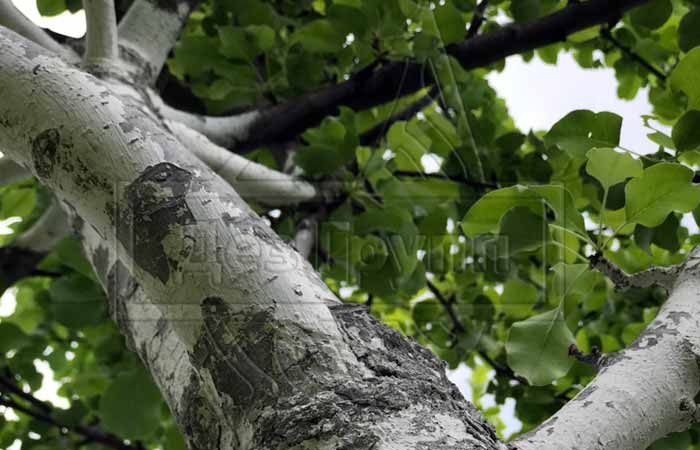

Environmental conditions have a strong impact on population size. In dry autumn and summer, the number of offspring decreases sharply.
Pest beetles can enter a person's home and destroy food. They are often found in cereals, flour, sugar. They enter the home through open windows and doors, with street debris and wood, and multiply in old frames and furniture.
Character and lifestyle
Beetles are predisposed to a terrestrial lifestyle. They live in small groups consisting of different species of the family. The dwelling is located in small layers of soil, under stones, at the base of shrubs and grasses. Only a few small species prefer to settle on shrubs and trees.
The daily activity of beetles distributes them into 3 types:
- daytime;
- night;
- daily.
Basically, insects are disposed to a nocturnal lifestyle, during which they hunt for food. Thanks to powerful and strong limbs, they quickly move over fairly long distances, for which they received the names - runners and runners.
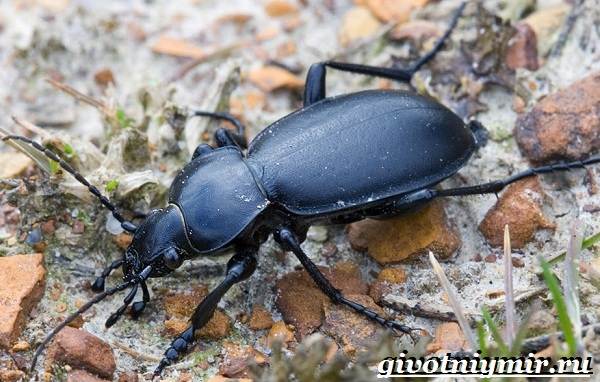

The daytime period is completely spent in their shelter. For wintering, towards the end of the autumn cold, they burrow into the ground until spring. With the onset of warmth, they rise to the surface and continue their vital activity.
Nicknamed the bombardier beetle Crimean ground beetle acquired thanks to the protective fluid in the anal gland. Throws it onto the enemy, sensing danger and pursuit.
The foul-smelling poisonous mixture reaches a hot temperature when released and explodes with a loud click, instantly evaporating in the form of a cloud. The frightened predator with tangible burns starts to flee. The stock of reagents is enough for 15-35 volleys.


Ground beetle larva
The life span of a ground beetle is about 3 years. In the process of development from egg to adult, it goes through two intermediate stages - pupa and larva.
Females lay a clutch in fertile soil, the number of oval smooth eggs in which can reach 250 pieces. The larvae appear on the 14th day.They are white in color and have 3 pairs of claw-like limbs. After 10 hours, the body of the larva acquires a black color with a purple tint, and on the second day they form powerful jaws. The ground beetle larva pupates at the end of spring and turns into an adult sexually mature individual.
Reproduction and life expectancy
Ground beetle refers to long-lived beetles - from 3 to 5 years. The insect's life cycle gradually passes from egg to larva, pupa and imago. The breeding season begins after the mating spring season, which usually takes place in the month of April.
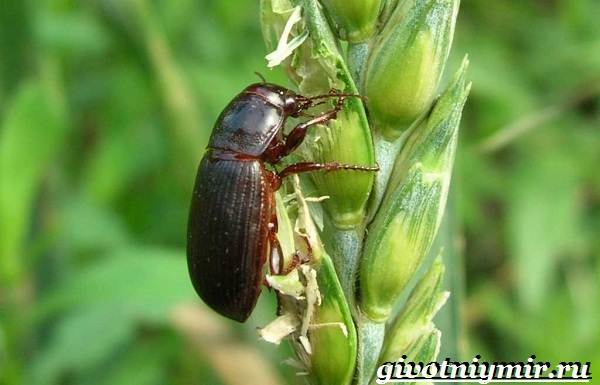

Bread beetle
One female spends a single clutch of 50-80 eggs directly into the soil to a depth of 3 cm. For this, she chooses a damp place with fertile soil. Larvae weighing up to 160 mg and up to 2 cm long appear after 13-14 days.
They have 6 short claw-like legs. Their white color becomes violet-black in 10 hours. The jaws of small predators after 40 hours from birth already have the power to eat land mollusks. Firmly clinging to the victim, despite its persistence and secretion of mucus and foam, buries itself with it in the soil and eats it.
The development of the larvae is completed by the end of summer. The next stage occurs - pupation, which lasts 15-25 days. The naked body of the pupa outwardly resembles an adult beetle.
A characteristic feature is tufts of protruding setae on the back and lateral surface of the abdominal segment. The pupa is mostly found in a cradle made of soil or substrate.


In winter, it enters the adult state with a duration of 2-3 years. The first appearance of young individuals depends on climatic conditions and is observed in the month of May-June. This mainly occurs at the beginning of the ripening of the grain crop.
Mass appearance can be seen in the milky stage of ripeness of winter crops. In August, it falls into diapause - a stop of the shaping process, and buries itself in the ground up to 40 cm.
Ground beetle harm
Is the ground beetle harmful to agricultural crops, is it dangerous to humans? The practical importance of insects is determined by the lifestyle and type of food. The main damage to cultivated plants is caused by phytophagous ground beetles:
- Bread beetle is an individual with a black-resin color and a body length of up to 1.5 cm. The insect feeds on cereals, young leaves of winter varieties, pollen and nectar, causing significant damage to agricultural farms.
- Ground beetle larvae prefer the juice of young seeds in rye, wheat and barley fields. They also feed on leek, oats, and corn.
A well-known representative of the mixed type of food is the millet ground beetle. In the conditions of abundant green spaces, the insect turns into a phytophage, in the absence of plants it becomes an entomophage.
On the territory of Russia, you can find useful entomophagous ground beetles. The most numerous species is the common ground beetle (garden). Distinctive features:
- long antennae;
- body up to 3 cm long with a brown or dark graphite color and a metallic sheen;
- golden blotches on elongated grooves in the flap area;
- powerful sickle-shaped jaws to hold the victim;
- developed strong limbs for fast movement and pursuit of the victim.
The garden ground beetle is classified as a useful insect with a nocturnal lifestyle. Its bite with powerful jaws is able to cope with the chitinous cover of any insect. The adult feeds on caterpillar larvae, beetles, snails, slugs and other insects that destroy cultivated plantations. During the season, one ground beetle eats more than 1000 pests of garden plants. The population of beneficial insects is decreasing every year. The main reasons are the destructive effects of pesticides and an increased interest in beetles on the part of collectors and tourists.
To maintain a high number of garden ground beetles, you should adhere to the following recommendations:
- protect the garden area from shrews, birds of prey, moles and other animals that eat useful beetles;
- carefully choose chemicals to protect plants from pests.
By destroying ground beetles and other pests with pesticides, a person often reduces the population of useful representatives of beetles. To prevent such consequences, it is better to entrust the choice of the method of struggle to qualified specialists. The workers will select the optimal preparation for getting rid of pests of cultivated plants, and will quickly process the territory with the help of professional equipment.
How to deal with a pest ground beetle
Malicious ground beetle, how to get rid of from an insidious predator - this question is relevant among many gardeners and gardeners. Insect damage brings troubles not only to agricultural plots, but also to houses, into which annoying beetles manage to penetrate.


An integrated approach with agrotechnical and chemical measures, with a quick harvest without spilling grain, contributes to maximum protection from the pest.
Black ground beetle for home - not a frequent and unpleasant phenomenon. Their stay in the apartment is not long due to the lack of food. However, they are capable of infecting all premises with larvae. The obvious factors in the spread of domestic beetles are:
- food products: flour, cereals, potatoes, etc .;
- food waste;
- rubbish;
- firewood;
- old wood.
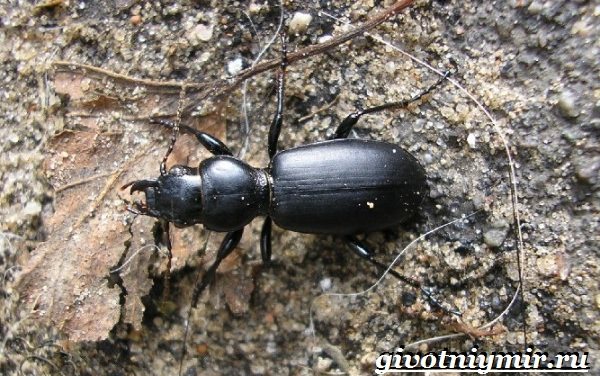

Taking immediate action to eliminate insects will help control the spread. In the fight against beetles, effective means are:
- general cleaning with a careful search for their location;
- surface treatment with baking soda or vinegar solutions;
- the use of insecticidal preparations for insects;
- protective mesh on the windows.
It is also necessary to monitor the safety of food in a closed form. Most of the ground beetle species reach large numbers and are of significant importance in the natural and anthropogenic ecosystem. Insects are indicators of the state of the environment and the presence of human contamination.
Enemies
Caucasian ground beetles are carnivorous predators; many species of ants and birds do not mind eating eggs, larvae and the beetles themselves. Many badgers and hedgehogs are potential threats to this species. Caucasian beetles can be a snack for bears and wild pigs. However, the greatest pests for the development of the population are ants, which climb into the shelter of ground beetles and eat their larvae and eggs. Ants do not risk attacking adults, since, due to their small size, they themselves will become a victim of an insect.
It is surprising that the Caucasian ground beetle feeds on many insect pests, so this representative has only a positive effect on the development of agricultural crops. However, many people do not know about this, therefore, when they see this representative, they try to destroy him immediately.
The population of the Caucasian ground beetle is under threat, and in order to prevent an even greater reduction of the species, this species was included in the Red Book of Russia and Georgia.
Means of struggle
In the case of this type of pest, there are several ways to destroy it. Prevention of reproduction is to prevent the rapid reproduction of the ground beetle. For this it is enough to remove the source of its power supply as much as possible. To understand how important such events are, it is worth comparing: with a sufficient amount of food, the female lays about 120 eggs, and without it - only 30. Therefore, after harvesting, it is worth clearing the field as soon as possible of stubble, into which females can lay eggs, and fallen grain that can germinate. Before sowing winter crops, cultivate the soil by deep plowing. And it is better to leave the field on which the crops grew, fallow or plant other crops.
Pre-sowing chemical treatment. It consists in the processing of grain intended for winter crops. The seed is exposed to insecticides such as "Cruiser", which destroy the larvae.
Spraying crops. The leaves of young plants and the soil around them are cultivated. Means of control - insecticides "Norton", "Aktara", "Eforia" and others. They affect both larvae and adults.
The common ground beetle is one of the most studied species. And there are still a lot of little-known representatives of the family and those that humanity has yet to recognize.
Lifestyle features
The Crimean ground beetle is active in the dark. Only intense hunger can make the predator appear during the day. Powerful long legs help the beetle to overtake the prey, thanks to which the insect is able to travel a path up to 2 thousand meters long. The beetle is so evasive and fast that not everyone will be able to catch it.
In case of danger, the Crimean ground beetle uses its defense mechanism. It releases a caustic, unpleasant odor liquid from the back of the abdomen. Due to this feature of the insect, most animals and birds try not to approach it.
On a note!
Contact with a corrosive liquid containing formic acid in a person's eyes can cause conjunctivitis.


Ground beetle habitat
What does it look like
The Crimean ground beetle is a beetle whose body length reaches 50 mm. Body color can range from blue-violet to black-green tones. Insects are characterized by optical coloration, which is formed as a result of the refraction of light on a coarse-grained wrinkled coating. This feature gives the impression that the color of the insect can change. The abdominal part of the body of the beetle is black, has a shiny metallic sheen.
On a note!
The males differ from the females with their long whiskers and extended forepaws.
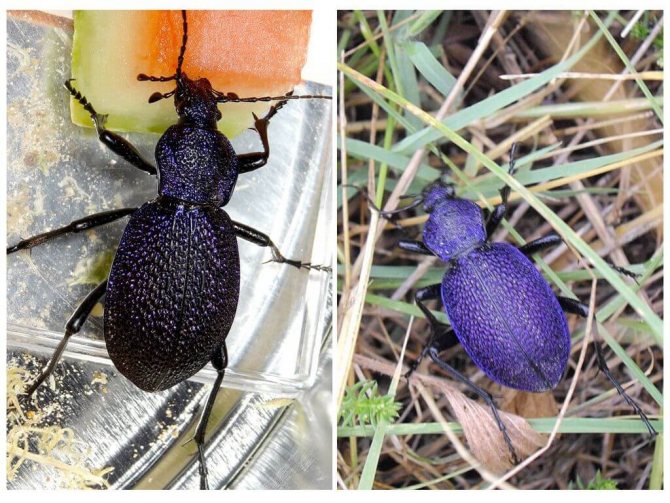

Crimean ground beetle
Insect harm to humans and plants
Bread beetle, as a rule, eats grain crops and can cause significant damage to the crop. Not only adults, but also larvae are engaged in the destruction of the crop. Adults suck out nutrients, and the larvae actively eat the green mass. They raid wheat, rye, barley, and sometimes eat corn, oats, etc. When there is not enough food for the beetle, it actively feeds on leek.
These beetles pose a certain danger to both cereals and foodstuffs that are in human dwellings. This beetle is active at night, and during the day it hides in various shelters. Once in a person's dwelling, he can take root if conditions are favorable for this and if an active struggle is not waged with him. As a rule, with the onset of darkness, he begins to look for food for himself.
He searches in the apartment for food leftovers left after dinner on the dining table, as well as stocks of bulk foodstuffs that are stored in kitchen furniture and have free access to them. In addition, they do not allow residents to sleep, making rustling sounds. After they have settled in a house or apartment, they should be expected to breed, which should not be allowed.
It's important to know! Having found a ground beetle in the house, it is necessary to immediately take measures to get rid of such a neighborhood before the beetles begin to multiply. The fewer the insects, the easier it is to deal with them.

